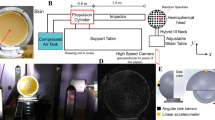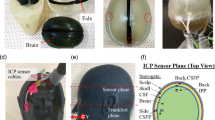Abstract
Brain pressure responses resulting from translational head impact are typically related to focal injuries at the coup and contrecoup sites. Despite significant efforts characterizing brain pressure responses using experimental and modeling approaches, a thorough investigation of the key controlling parameters appears lacking. In this study, we identified three parameters specific and important for brain pressure responses induced by isolated linear acceleration \((a_{\text {lin}} )\) via a dimensional analysis: \(a_{\text {lin}} \) itself (magnitude and directionality), brain size and shape. These findings were verified using our recently developed Dartmouth Head Injury Model (DHIM). Applying \(a_{\text {lin}} \) to the rigid skull, we found that the temporal profile of the given \(a_{\text {lin}} \) directly determined that of pressure. Brain pressure was also found to be linearly proportional to brain size and dependent on impact direction. In addition, we investigated perturbations to brain pressure responses as a result of non-rigid skull deformation. Finally, DHIM pressure responses were quantitatively validated against two representative cadaveric head impacts (categorized as “good” to “excellent” in performance). These results suggest that both the magnitude and directionality of \(a_{\text {lin}} \) as well as brain size and shape should be considered when interpreting brain pressure responses. Further, a model validated against pressure responses alone is not sufficient to ensure its fidelity in strain-related responses. These findings provide important insights into brain pressure responses in translational head impact and the resulting risk of pressure-induced injury. In addition, they establish the feasibility of creating a pre-computed atlas for real-time tissue-level pressure responses without a direct simulation in the future.










Similar content being viewed by others
References
Abaqus (2012) Abaqus Online Documentation. Abaqus 6:12
Arun K, Huang T, Blostein S (1987) Least-squares fitting of two 3-D point sets. Pattern Anal Mach Intell PAMI 9:698–700
Centers for Disease Control and Prevention (2003) Report to congress on mild traumatic brain injury in the United States: steps to prevent a serious public health problem, pp 1–45
Chafi MS, Dirisala V, Karami G, Ziejewski M (2009) A finite element method parametric study of the dynamic response of the human brain with different cerebrospinal fluid constitutive properties. Proc Inst Mech Eng Part H J Eng Med 223:1003–1019. doi:10.1243/09544119JEIM631
Chen Y, Ostoja-Starzewski M (2010) MRI-based finite element modeling of head trauma: spherically focusing shear waves. Acta Mech 213:155–167. doi:10.1007/s00707-009-0274-0
De Lange R, van Rooij L, Mooi H, Wismans J (2005) Objective biofidelity rating of a numerical human occupant model in frontal to lateral impact. Stapp Car Crash J 49:457–79
Gibson LJ (2006) Woodpecker pecking: how woodpeckers avoid brain injury. J Zool 270:462–465. doi:10.1111/j.1469-7998.2006.00166.x
Greenwald R, Gwin J, Chu J, Crisco J (2008) Head impact severity measures for evaluating mild traumatic brain injury risk exposure. Neurosurgery 62:789–798. doi:10.1227/01.NEU.0000311244.05104.96
Gurdjian E, Lissner H, Evans F et al (1961) Intracranial pressure and acceleration accompanying head impacts in human cadavers. Surg Gynecol Obstet 113:185–190
Hardy WN, Mason MJ, Foster CD et al (2007) A study of the response of the human cadaver head to impact. Stapp Car Crash J 51:17–80
Horgan TJ, Gilchrist MD (2003) The creation of three-dimensional finite element models for simulating head impact biomechanics. Int J Crashworthiness 8:353–366. doi:10.1533/cras.8.4.353.19278
Horgan TJ, Gilchrist MD (2004) Influence of FE model variability in predicting brain motion and intracranial pressure changes in head impact simulations. Int J Crashworthiness 9:401–418. doi:10.1533/ijcr.2004.0299
Ji S, Zhao W (2014) A pre-computed brain response atlas for instantaneous strain estimation in contact sports. Ann Biomed Eng (in press)
Ji S, Ghadyani H, Bolander RP et al (2014a) Parametric Comparisons of Intracranial Mechanical Responses from three validated finite element models of the human head. Ann Biomed Eng 42:11–24. doi:10.1007/s10439-013-0907-2
Ji S, Zhao W, Ford JC et al (2014b) Group-wise evaluation and comparison of white matter fiber strain and maximum principal strain in sports-related concussion. J Neurotrauma (in press). doi:10.1089/neu.2013.3268
Ji S, Zhao W, Li Z, McAllister TW (2014c) Head impact accelerations for brain strain-related responses in contact sports: a model-based investigation. Biomech Model Mechanobiol 13:1121–36. doi:10.1007/s10237-014-0562-z
Kang H, Willinger R, Diaw B, Chinn B (1997) Validation of a 3D anatomic human head model and replication of head impact in motorcycle accident by finite element modeling. In: Proceedings of the 41st stapp car crash conference
Kimpara H, Iwamoto M (2012) Mild traumatic brain injury predictors based on angular accelerations during impacts. Ann Biomed Eng 40:114–26. doi:10.1007/s10439-011-0414-2
Kimpara H, Nakahira Y, Iwamoto M et al (2006) Investigation of anteroposterior head-neck responses during severe frontal impacts using a brain-spinal cord complex FE model. Stapp Car Crash J 50:509–44
King A, Ruan J, Zhou C (1995) Recent advances in biomechanics of brain injury research: a review. J Neurotrauma 12:651–658
King A, Yang K, Zhang L (2003) Is head injury caused by linear or angular acceleration. In: Proceedings of international research conference on the biomechanics of impacts. Lisbon, Portugal, pp 1–12
Kleiven S (2006) Evaluation of head injury criteria using a finite element model validated against experiments on localized brain motion, intracerebral acceleration, and intracranial pressure. Int J Crashworthiness 11:65–79. doi:10.1533/ijcr.2005.0384
Kleiven S (2007) Predictors for traumatic brain injuries evaluated through accident reconstructions. Stapp Car Crash J 51:81–114
Kleiven S, Hardy WN (2002) Correlation of an FE model of the human head with local brain motion—consequences for injury prediction. Stapp Car Crash J 46:123–144
Kleiven S, von Holst H (2002) Consequences of head size following trauma to the human head. J Biomech 35:153–60
Kraft RH, McKee PJ, Dagro AM, Grafton ST (2012) Combining the finite element method with structural connectome-based analysis for modeling neurotrauma: connectome neurotrauma mechanics. PLoS Comput Biol 8:e1002619. doi:10.1371/journal.pcbi.1002619
Levin H, Kraus MF (1994) The frontal lobes and traumatic brain injury. J Neuropsychiatry Clin Neurosci 6:443–54
Libertiaux V, Pascon F, Cescotto S (2011) Experimental verification of brain tissue incompressibility using digital image correlation. J Mech Behav Biomed Mater 4:1177–85. doi:10.1016/j.jmbbm.2011.03.028
Mao H, Zhang L, Jiang B et al (2013) Development of a finite element human head model partially validated with thirty five experimental cases. J Biomech Eng 135:111002–15. doi:10.1115/1.4025101
Meaney DF, Morrison B, Bass CR (2014) The mechanics of traumatic brain injury: a review of what we know and what we need to know for reducing its societal burden. J Biomech Eng. doi:10.1115/1.4026364
Morse JD, Franck J, a, Wilcox BJ, et al (2014) An experimental and numerical investigation of head dynamics due to stick impacts in Girls’ Lacrosse. Ann Biomed Eng. doi:10.1007/s10439-014-1091-8
Nahum A, Smith R, Ward C (1977) Intracranial pressure dynamics during head impact. SAE technical paper no. 770922
Newman J (1986) A generalized acceleration model for brain injury threshold (GAMBIT). In: Proceedings of international research conference on the biomechanics of impacts, pp 121–131
Newman J, Shewchenko N (2000) A proposed new biomechanical head injury assessment function—the maximum power index. Stapp Car Crash J 44:215–247
Rowson S, Duma SM (2013) Brain injury prediction: assessing the combined probability of concussion using linear and rotational head acceleration. Ann Biomed Eng 41:873–882. doi:10.1007/s10439-012-0731-0
Ruan J, Prasad P (2006) The influence of human head tissue properties on intracranial pressure response during direct head impact. Int J Veh Saf 1:281–291
Ruan J, Prasad P (2001) The effects of skull thickness variations on human head dynamic impact responses. Stapp Car Crash J 45:395–414
Ruan JS, Khalil T, King AI (1994) Dynamic response of the human head to impact by three-dimensional finite element analysis. J Biomech Eng 116:44–50
Sano K, Norio N (1967) Mechanism and dynamics of closed head injuries (preliminary report). Neurol Med Chir (Tokyo) 9:21–33
Sonin A (2001) The physical basis of dimensional analysis, 2nd edn. MIT, Cambridge
Takhounts EG, Craig MJ, Moorhouse K et al (2013) Development of brain injury criteria (Br IC). Stapp Car Crash J 57:243–266
Takhounts EG, Ridella SA, Tannous RE et al (2008) Investigation of traumatic brain injuries using the next generation of simulated injury monitor (SIMon) finite element head model. Stapp Car Crash J 52:1–31
Thomas LM, Roberts VL, Gurdjian ES (1966) Experimental intracranial pressure gradients in the human skull. J Neurol Neurosurg Psychiatry 29:404–11
Trosseille X, Tarriere C, Lavaste F et al (1992) Development of a FEM of the human head according to a specific test protocol. In: Proceedings of the 46th stapp car conference, pp 235–253
Tse K, Tan L, Lee S (2013) Development and validation of two subject-specific finite element models of human head against three cadaveric experiments. Int J Numer Method Biomed Eng 30:397–415. doi:10.1002/cnm
Ward C, Chan M, Nahum A (1980) Intracranial pressure-A brain injury criterion. SAE technical paper 801304. doi:10.4271/801304
Wright RM, Post A, Hoshizaki B, Ramesh KT (2013) A multiscale computational approach to estimating axonal damage under inertial loading of the head. J Neurotrauma 30:102–18. doi:10.1089/neu.2012.2418
Yoganandan N, Arun MWJ, Pintar FA (2014) Normalizing and scaling of data to derive human response corridors from impact tests. J Biomech 47:1749–1756. doi:10.1016/j.jbiomech.2014.03.010
Yoganandan N, Gennarelli Ta, Zhang J et al (2009) Association of contact loading in diffuse axonal injuries from motor vehicle crashes. J Trauma 66:309–315. doi:10.1097/TA.0b013e3181692104
Yoganandan N, Pintar FA, Sances A et al (1995) Biomechanics of skull fracture. J Neurotrauma 12:659–668
Zhang L, Yang K, King A (2001a) Comparison of brain responses between frontal and lateral impacts by finite element modeling. J Neurotrauma 18:21–30. doi:10.1089/089771501750055749
Zhang L, Yang KH, Dwarampudi R et al (2001b) Recent advances in brain injury research: a new human head model development and validation. Stapp Car Crash J 45:369–94
Zhang L, Yang KH, King AI (2004) A proposed injury threshold for mild traumatic brain injury. J Biomech Eng. doi:10.1115/1.1691446
Acknowledgments
This work was sponsored, in part, by the NIH Grant R21 NS078607 and the Dartmouth Hitchcock Foundation.
Conflict of interest
No competing financial interests exist.
Author information
Authors and Affiliations
Corresponding author
Rights and permissions
About this article
Cite this article
Zhao, W., Ruan, S. & Ji, S. Brain pressure responses in translational head impact: a dimensional analysis and a further computational study. Biomech Model Mechanobiol 14, 753–766 (2015). https://doi.org/10.1007/s10237-014-0634-0
Received:
Accepted:
Published:
Issue Date:
DOI: https://doi.org/10.1007/s10237-014-0634-0




